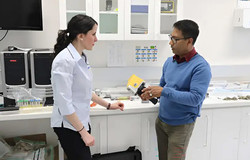
Handheld scanner determines seafood origin, production method
Editor/Mohamed Shihab
BY:Emma Desrochers-Contributing editor reporting from Hawaii, U.S.A.
The innovative tool aims to combat seafood fraud that deceives customers buying seafood at retail.
Australian researchers have developed a handheld device capable of determining seafood provenance that can distinguish whether a piece of seafood was wild-caught or farmed.
The device, which stems from a collaborative effort led by Australia’s Nuclear Science and Technology Organization (ANSTO) and included researchers at Australian governmental departments and Sydney-based universities, discerns the origin and production method of seafood by analyzing a distinctive chemical fingerprint on a piece of seafood. The fingerprint on the piece of seafood comes from the animal's diet, the climate in which it lived or was raised, and other factors, and is scanned for by the device and compared to a compiled list of species samples taken from all over Australia.
"This device is really about empowering the consumer, empowering the retailer, and also empowering the wholesalers to know more about the produce they're buying and selling," University of New South Wales School of Biological, Earth, and Environmental Sciences Associate Professor Jes Sammut – who contributed to the tool’s development – said.
Through that empowerment, the tool largely aims to prevent seafood fraud, which occurs when either a seafood product's species, origin, or both is mislabeled. There are tools present in the market that can analyze a piece of seafood’s DNA, but DNA can only identify species, not origin or production method.
"The idea is to use the handheld device at any point in the supply chain, providing details that can lead to a more sustainable and ethical seafood trade," Sammut said.
Over 60 percent of seafood consumed in Australia is imported, and that high reliance on imports has contributed to frequent occurrences of seafood mislabeling, Sammut said, wherein cheaper species are sold at higher prices.
"We hope this tool will help advance country-of-origin labeling, and that could mean your local fish-and-chip shop will need to state the geographical origin of a product, including whether it was farmed or wild. So again, this tool is a way of ensuring this compliance," Sammut said.
Seafood mislabeling also conceals critical information regarding species sustainability, including whether seafood has been legally harvested. The provenance of a piece of seafood could indicate it potentially originates from vessels or companies that perpetuate forced labor and other forms of illegal, unreported, and unregulated (IUU) fishing practices such as overfishing.
"For example, a product may say that it's a barramundi fillet from Australia, when it's really a barramundi fillet from overseas," Sammut said.
Researchers said the tool’s development process was also sustainable itself, as they repurposed already existing handheld elemental scanners, originally designed for sediment analysis, to scan the biological tissue of seafood. A study published by the research team demonstrated the repurposed device could identify the origin of black tiger prawns from various regions of Australia with over 80 percent accuracy.
"Technological innovations such as this scanner will play an important role in the prevention of food fraud in years to come," Sydney Fish Market Innovation and Technical Manager Erik Poole said. "Most importantly, by demystifying the supply chain and providing consumers with trustworthy information about seafood provenance, we hope that research like this equips Australians with the tools to confidently choose Australian seafood, whenever possible."


ساحة النقاش